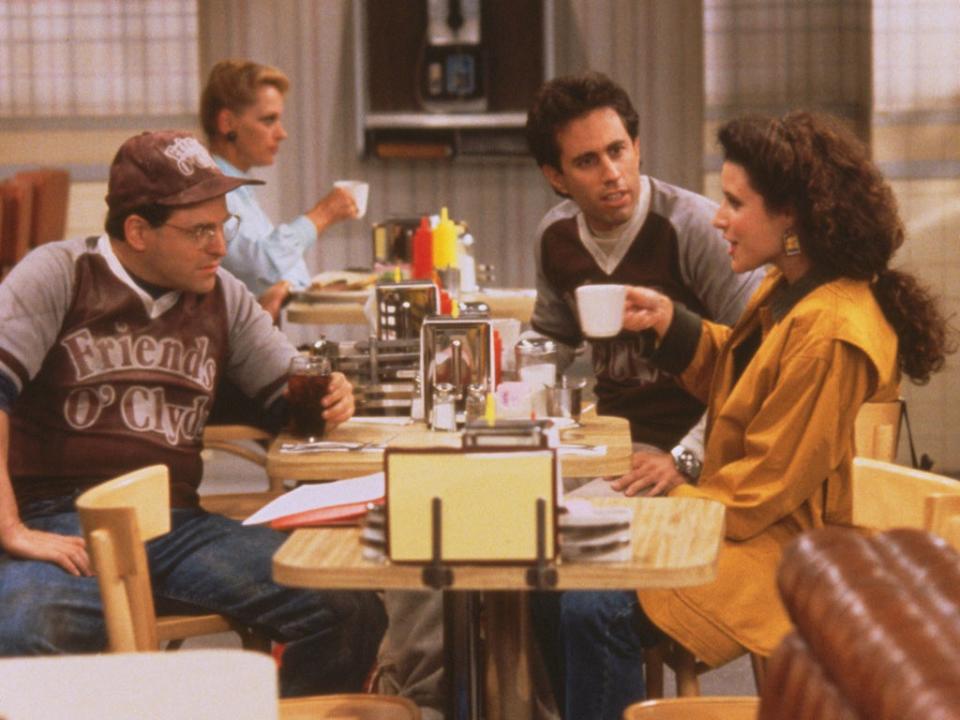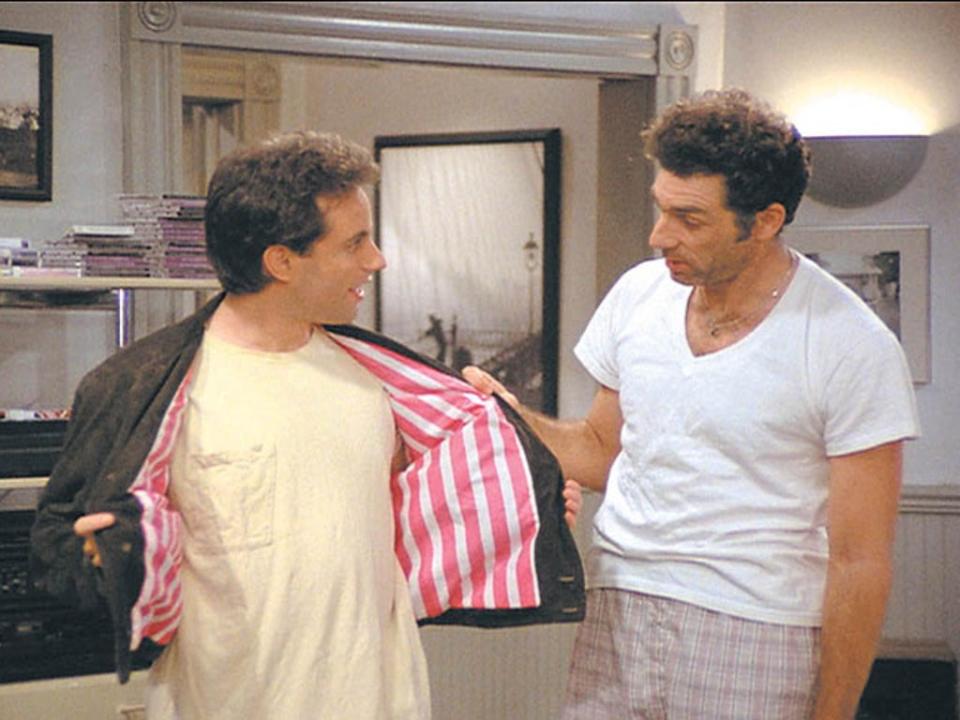Seinfeld is arriving on Netflix... is this the moment Britain finally falls in love?

What’s the deal with British people and Seinfeld? Ordinarily, American culture has no trouble whatsoever finding a willing audience on our shores. From gritty dramas like The Walking Dead to frothy comedies such as Friends, US TV usually slips unimpeded into the UK’s bloodstream like a lab-grown supervirus. But not Seinfeld. In its native US, Jerry Seinfeld’s ground-breaking sitcom was a hit of obscene proportions. Its creator and star became an immediate household name, and, before long, the richest comedian in the world. The language of the show seeped into the vernacular of the American everyday – from “yada yada yada” to “not that there’s anything wrong with that”. When Seinfeld went off air, its finale was watched by more than 75 million people. Here in the UK, however, you’d be forgiven for wondering why there’s so much ado about the show about nothing.
This may all be about to change, however. Tomorrow, Seinfeld arrives on Netflix in its entirety – all 180 episodes’ worth. It’s not the first time the series has been available to stream – Sky and Amazon Prime have both carried it in the UK in recent memory – but it is the most accessible it’s ever been. Netflix acquired the global rights to Seinfeld in a five-year deal reportedly worth more than what it paid for both The Office, at $500m, and Friends ($400m), though each of those agreements only covered US rights. The series is finally going to be placed in front of the biggest possible audience, in a format that is made for bingeing. Could this be the moment when the UK finally gives Seinfeld the attention it deserves?
For those unfamiliar, a bit of background about the series. In the late 1980s, Jerry Seinfeld was a jobbing stand-up who’d gained some level of visibility through a series of well-received sets on late-night talk shows. NBC sought a deal to work with Seinfeld, originally planning to shoot a one-off comedy special. To write this with him, Seinfeld recruited his friend, Larry David, whose own promising stand-up career was hampered by an abrasive, often combative relationship with his audience (by his own admission, he once walked on stage, took a look at the crowd, shook his head and left, because he “sensed no connection with them”).
Together they cooked up an idea for a special, the premise being “How a comedian got his material”. Eventually this was tweaked to a half-hour pilot, because Seinfeld doubted the premise would stretch over a full-length special. “We just didn’t think you could sustain that for 90 minutes,” he later said. “So instead we ended up making 90 hours.”
The original pilot, off-puttingly titled The Seinfeld Chronicles, starred Seinfeld as a fictional version of himself. Jason Alexander, a short, balding actor with a background in stage musicals, was cast as George Costanza, Jerry’s friend and a de facto stand-in for Larry David (a fact that would become a running joke on David’s later project, Curb Your Enthusiasm). The gifted physical comedian Michael Richards was brought on to play Jerry’s neighbour Kramer, a live-wire eccentric based on David’s own neighbour, Kenny Kramer. Though the pilot was received poorly by test audiences, NBC greenlit a short first season – just five episodes, almost a slap in the face by most measures – with one stipulation. They insisted that Seinfeld add a woman to the main cast. So Julia Louis-Dreyfus was cast as Elaine, Jerry’s ex-girlfriend. The last strike of lightning had entered the bottle.
Seinfeld was, in many ways, a reaction to the conventions of the sitcom form. Before Seinfeld, American sitcoms – even the superior examples, like M*A*S*H, Taxi or Cheers – were unabashedly sentimental. This went out the window with Seinfeld, which abided utterly by David’s “no hugging, no learning” mantra. The early storylines tended to be brazenly antidramatic, with whole episodes devoted to premises such as “waiting to be seated at a Chinese restaurant”, or “wandering around a multi-storey car park”. By later seasons, this had somehow snowballed into the exact opposite, with each episode comprising several oversized, comically improbable scenarios that would crash together at each story’s end.
But despite this changing sensibility, and the departure of David two seasons before its conclusion, Seinfeld never jumped the shark or lost what made it great. This can be put down to the show’s writing – an admirably consistent string of smart and surprising jokes, peppered with quotable, zeitgeisty observations about New York life in the 1990s – and four characters pretty much as timeless as any to have graced television. Alexander, Louis-Dreyfus and Richards were all sublime, delivering finely honed character work that was unceasingly funny. In a just world, “Alexander’s Costanza” would be uttered in the same breath as “Olivier’s Hamlet”. Seinfeld, meanwhile, was conspicuously the worst actor of the bunch, but this hardly mattered. His interstitial stand-up routines were always amusing, and the scenes in which his straight face falters hold a rare, blooperish delight.

Since the finale first aired, nearly a quarter of a century ago, the cast and creators’ trajectories have splintered in every direction. After playing such a part in articulating the 1990s zeitgeist, Seinfeld himself switched to heading up projects that were almost perversely unfashionable (notably the children’s animation Bee Movie and the online interview series Comedians in Cars Getting Coffee). Richards’s career ended in a day, after an infamous racist outburst in a comedy club. Alexander has enjoyed a number of creditable parts across film and TV, but he is still widely known to the world only as the buffoonish George Costanza (another running joke in Curb). Louis-Dreyfus is the exception: her seven-season run on Veep has arguably eclipsed her work on Seinfeld, at least in terms of acclaim, though for many she’ll always be most fondly remembered as Elaine Benes.
Why didn’t the series ever truly take off in the UK? It’s possible that Brits just weren’t tuned in to the rhythms of Seinfeld’s idiosyncratic New York-Jewish humour. Too glib, perhaps. Or too ironic. Maybe the references were just too alien. The jokes about Junior Mints, delis and John Cheever sailed over our heads, it’s true. What could he mean by that? If Seinfeld were to riff about Murray Mints, chippies and Martin Chivers, maybe it’d be a different story. It could also be that the lack of an emotional through-line proved off-putting; Americans aren’t the only ones who tend to insist on a little pathos. Even The Office had a sentimental streak.

But the best explanation for the show’s failure to take root here comes down to access. Back during its original run, the series was mostly shown late at night, on BBC2’s midnight slot. The DVD era increased its audience substantially: though this was a series that had little interest in character arcs or long-form storytelling, viewers still benefitted from understanding the many running jokes and callbacks that littered the dialogue. And they didn’t have to stay up until the wee hours just to watch it. Seinfeld is, in many ways, perfect for Netflix. It’s easy to pick up wherever, endlessly rewatchable, and, significantly, there’s lots and lots of it.
Even those who are completely new to Seinfeld’s charms will surely be familiar with its legacy. The show’s influence can be seen in countless sitcoms that followed. In early reviews, Friends was compared widely and dismissively to Seinfeld, having mimicked its “young adult friends in New York” premise while paring back Seinfeld’s absurdity and reintroducing some of the traditional “hugging and learning” that David so despised. It’s Always Sunny in Philadelphia has often been described as “Seinfeld on [class A drug of choice]”, pushing the ethos of unlikeable and incorrigible characters to new and hilarious extremes.
Some of Seinfeld’s jokes have aged like fine wine, while others (particularly the broader gender-divide commentary) have aged like milk. Admittedly, a cocktail of curdled milk and Château Lafite doesn’t exactly sound like something you’d want to drink. But the series’ strengths – the performances, the sheer irreverent confidence of its humour – make its shortcomings easy to overlook. This is one relic of the Nineties that’s well worth digging up.
Read More
100 days of GB News: Why this nasty channel was always going to be a chaotic and hateful mess
Fred Hechinger: ‘I find, even at its best, life to be somewhat lonely’
Sex Education gives disabled characters’ love lives the respect they deserve
Squid Game and the rise of the ‘deadly game’ TV show
Why GB News was always going to be a chaotic and hateful mess
The last Vigil episode offered sharks, sacrifices and an explosive finale – recap

 Yahoo Movies
Yahoo Movies 